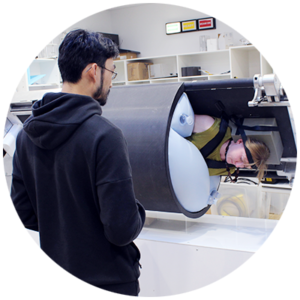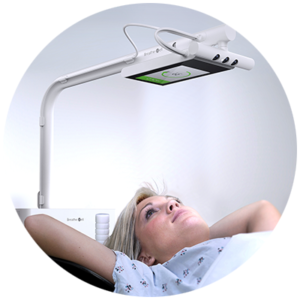Clinical Trials
We partner with leading health providers in NSW and across the world to conduct clinical trials that translate our research in to solutions that directly improve the lives of patients. Clinical trials are the key to the development of safe, effective health technology.
For International Clinical Trials Day 2021, we prepared a short video about the work we do, and how much we value the patients and trial teams helping us to improve the gold standard of cancer treatment.
Accurate Treatment for Lung Tumours
AVIATOR: Audio-Visual Investigation Advancing Thoracic Radiotherapy.
Lungs tumours are difficult to treat with a static radiation beam because they’re in constant motion as the patient breathes. We’re trialing technology developed by our researchers that uses real-time information about the patient’s breath to indicate the tumour location.
The technology monitors the motion of the chest rising and falling, and coaches the patient to have steady breath and breath-holds which put the tumour in the right position for treatment. This helps the radiation therapist to hit the tumour with radiation even more accurately. The technology has already been successfully trialed for breast cancer patients. In this study, we’ll determine whether our technology will offer the same treatment improvements for people with lung cancer.
This is the largest study of its kind to date, performed across 7 radiation oncology departments and 75 patients across NSW and ACT.
Sites: Westmead Hospital, Canberra Hospital and Calvary Mater Hospital
Technology: AV Biofeedback
More information: Available at the Australia and New Zealand Clinical Trials Registry here.

Measuring the patient’s experience of horizontal rotation
Patient Experience and Acceptance of Horizontal Rotation.
Nano-X is a new radiotherapy machine designed and built in Sydney, consisting of a patient rotation system together with a radiotherapy system. Nano-X proposes rotating the patient rather than rotating the enormous weight of the radiation therapy gantry. The NanoX is designed to be a low-cost radiotherapy system to allow for rural areas and developing countries to be able to access high quality cancer treatment.
This would substantially decrease the cost and size of conventional radiotherapy machines. In this trial, we will use the Nano-X patient rotation system only, without the radiotherapy system. We are collecting feedback from patient volunteers to determine whether rotation is an acceptable experience.
Site: Prince of Wales Hospital
Technology: Nano-X
More information: Available at the Australia and New Zealand Clinical Trials Registry here.

Better cancer imaging for lung tumours.
ADAPT – Adaptive image acquisition for personalised thoracic imaging.
In this trial, we’re using a new technology (Respiratory Motion Guided 4DCBCT) for the pre-treatment imaging of lung cancers.
The technology measures the patient’s breath and ensures that images are taken at the optimum moment – avoiding any blurring caused by respiration or coughing.
By adapting the imaging to the dynamic movement of the patient, we will be able to acquire better quality images of a patients lungs for radiotherapy treatments.
Sites: Liverpool Hospital, Macarthur Hospital
Collaborating Group: TROG Cancer Research
Technology: RMG4DCBCT
More information: Available at the Australia and New Zealand Clinical Trials Registry here.

Saving the heart from damage during breast cancer radiation therapy.
Deep Inspiration Breath Hold and BRAVEHeart.
We have developed a device to help patients manage Deep Inspiration Breath Hold (DIBH) – a technique where patients take a deep breath and hold it while radiation therapy is being delivered. Filling the lungs with air increases the distance between the target of radiation therapy (a lung or breast tumour) and the heart.
This reduces the chance of the heart tissue being damaged during radiation treatment. The BRAVEHeart trial uses an audiovisual feedback device (Breathe Well) to assist the patient in controlling their breathing pattern and it will be tested in patients undergoing treatment for breast cancer.
Site: Royal North Shore Hospital
Technology: AV Biofeedback
More information: Available at the Australia and New Zealand Clinical Trials Registry here.

Improving new radiation therapy techniques for treating liver cancer.
LARK: Liver Ablative Radiotherapy utilising Kilovoltage Intrafraction Monitoring.
The LARK trial looks at treatment outcomes and treatment efficiency when incorporating our KIM technology with SABR, a new and effective radiation therapy technique that is becoming widely used.
KIM technology provides the radiation therapist with real-time information about the exact location of the tumour. This trial will determine how effectively KIM helps the radiation therapist deliver a more accurate radiation dose. Participants have fiducial markers inserted around their tumours to allow the KIM system to track tumour movement as the patient breathes.
Sites: Westmead Hospital, Nepean Hospital, Princess Alexandra Hospital
Technology: Kilovoltage Intrafraction Monitoring (KIM)
Collaborating Group: TROG Cancer Research
More information: Available at the Australia and New Zealand Clinical Trials Registry here.

Upcoming Trials
MAGIK
This trial will use implanted markers to determine the feasibility of Markerless Image Guidance using Intrafraction Kilovoltage X-ray Imaging. It is a Phase I Interventional Study of Lung Cancer Radiotherapy
Study size: 30 patients
Sites: The Alfred Hospital
Nano-X Image Guidance
In this trial, we will use the Nano-X patient rotation system with the radiotherapy system, to rotate patients whilst imaging them.
Site: Prince of Wales Hospital
SMART
We have developed a mask-free system to remove the need for a thermoplastic immobilisation mask for patients being treated with radiotherapy for Head and Neck Cancer. This trial will look at the technical feasibility of our surface monitoring technology, as well as patient acceptance of the mask-free system. Our surface monitoring technology has been specifically designed to accurately collect data about location and movement, and reduce anxiety and discomfort in participants.
Site: Blacktown Hospital

